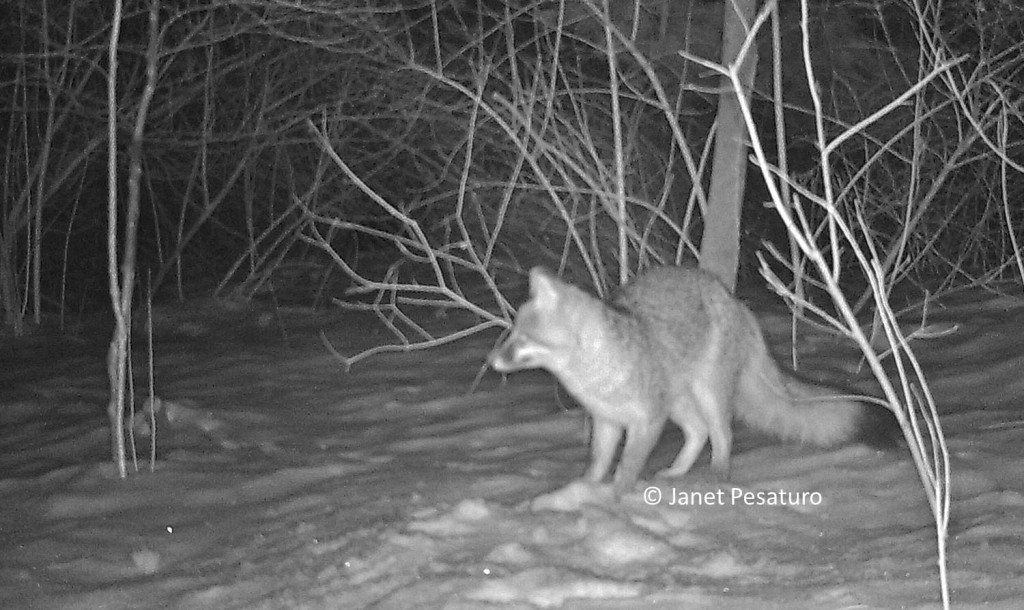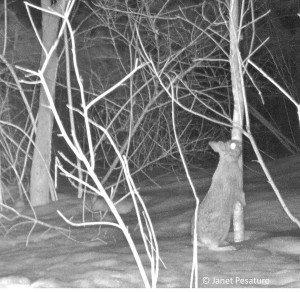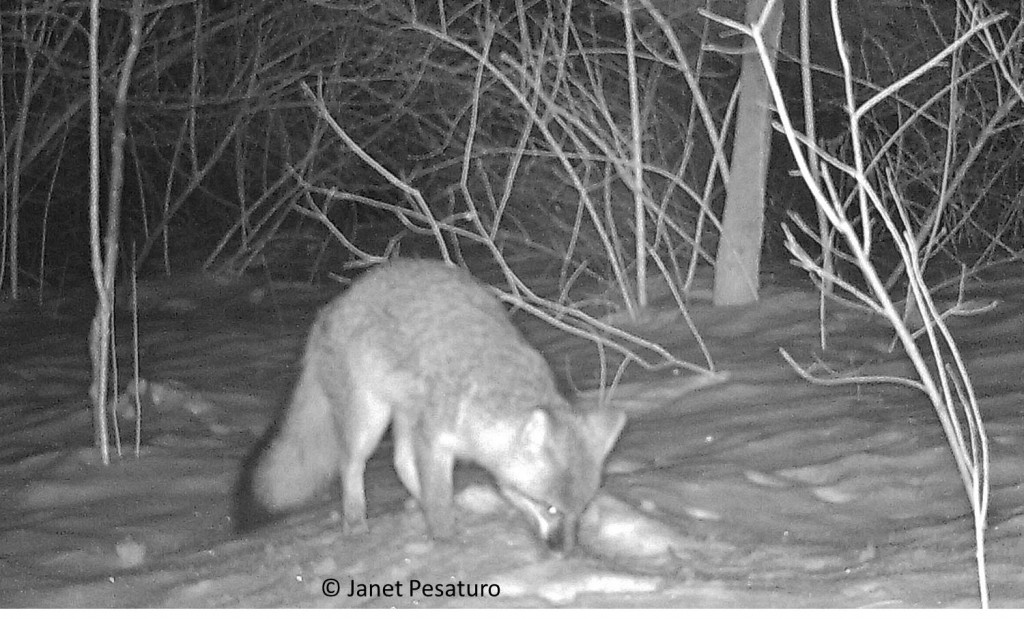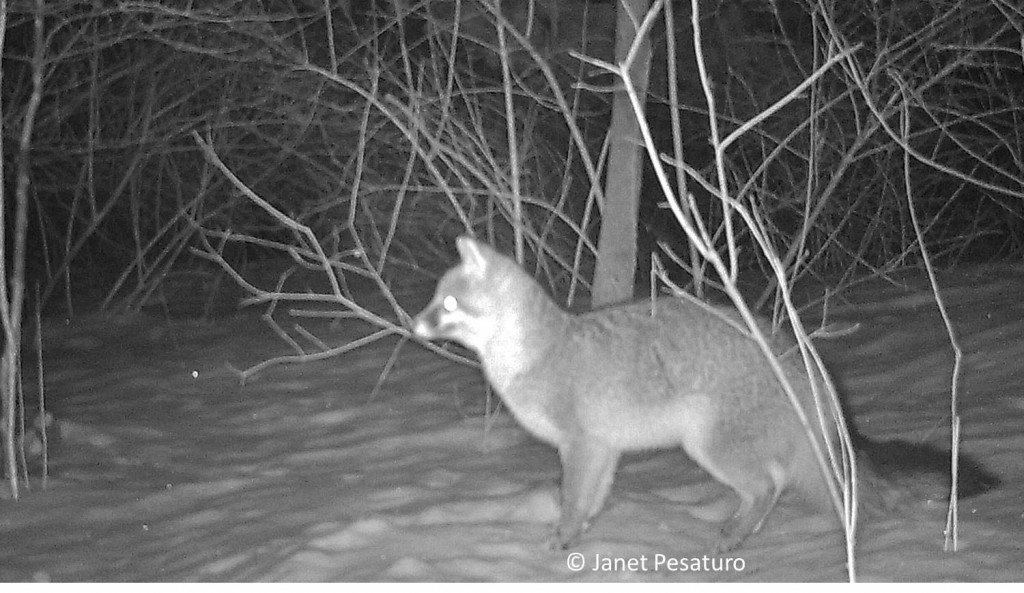The gray fox is one of two fox species we have here in Massachusetts. A lot of people think it’s rare, because they don’t see them as often as they see the red fox. But that probably has more to do with the nature of the two beasts, the red being bold and the gray more secretive around people. In any case, I was thrilled to capture some nice photos of this gray fox on my roadkill baited trail camera.
If you get a good look, it’s easy to distinguish between the two species. The red fox has black feet and lower legs, and a white tipped tail, as you can see here. The gray fox, on the other hand, has pale feet and legs, and a black tipped tail. The two foxes are about the same size (around 7-14 lbs), but the red fox has a slender build, while the gray fox is a little shorter and stockier.

Gray fox at snow covered deer carcass pauses cautiously. The black tipped tail and pale legs and feet distinguish it from the red fox.

Cottontails are abundant where the deer carcass was placed, so the fox might be getting plenty to eat, despite the inaccessibility of the deer.
Gray foxes thrive at edge habitat, where field meets forest, especially if the forest is young and brushy. It preys on cottontails and other small mammals which also thrive in edges. This is exactly the habitat in which we placed the road killed deer used for bait at this camera trap. I used a Moultrie M80 Moultrie Game Spy M80-XT Infrared Flash CameraAs you can see it takes some nice photos, even at night. I also use these 2 cameras with excellent results:
Moultrie M-990i No Glow Game Camera
Moultrie M-880 Low Glow Game Camera
After we set the deer and camera in pace, a storm or two covered the deer with more than a foot of snow. The gray fox was the first to sniff it out. I was amazed that anything could smell a frozen body buried under that much snow.
The fox came for 4 consecutive nights, attempting to dig, but the hard crust over deep snow was too much. Maybe the fox gave up, because it hasn’t visited since March 5th, even though a bobcat finally opened the carcass. But that’s a future post. Will the fox return? The camera and most of the deer are still there, so stay tuned.
Interested in setting up your own camera trap? Check out my post How to Set up a Camera Trap
Questions? Comments? I love ’em, so go ahead and make my day.
Shared on: Backyard Farming Connection #73, Tuesdays with a Twist #51, Wildcrafting Wednesday #130, Down Home blog hop #81, Wicked Awesome Wednesday #153, Mountain Woman Rendezvous #39, HomeAcre Hop #63, From the Farm blog hop, Freedom Fridays #21, Homesteaders Hop #6, Simple Life Sunday #11, Wordless Wednesday #86














Your trail cam pictures are great. We have both the gray and red foxes but don’t see as many as we used to. We’re told the coyotes are killing them and everything they eat. Love your blog!
Rita
Thanks, Rita. I’m delighted you enjoy my blog! I hope you read Rick’s comment below. There are many possible reasons for changes in animal populations, and I’m always suspicious of any explanation that vilifies one species.
Rita, red foxes are also highly susceptible to sarcoptic mange. When the population of fox and/or coyote get high enough they transfer it to one another… Gray foxes seem to have a natural resistance to mange. red foxes were introduced to the US from Europe and did not coevolve with mange.
Thanks for the info on the role of mange in red fox and coyote populations. On the subject of red fox’s status as native or introduced, a recent genetic study provides pretty strong evidence that red foxes are indeed native: http://www.fs.fed.us/pnw/pubs/journals/pnw_2012_statham001.pdf
My understanding is that past assertions that northeastern red foxes derive from introduced European red foxes were based largely on assumption, without support from morphometric studies. Now that assertion is not supported by genetic studies, either.
what a cute animal, yet dangerous to our pets. can’t believe it came 4 nights.
Dangerous to very small pets, like chickens and rabbits, and to kittens and small puppies, but not to adult cats and dogs.
These are some great pics you’ve captured. I’m afraid we are over-run with gray foxes. They we’re the demise of our little group of hens. Of course we’ve seen none since we were without chickens. I believe they are some of the most extremely cunning, sly and adaptive creatures you’re going to find.
Thanks for sharing your interesting post.
Thanks. Yes, foxes are common, but I’m willing to bet they think they’re “over-run” with humans. We don’t respect their property anymore than they respect/recognize ours, lol.
We have worked pretty hard at keeping our chicken set-up predator resistant, and so far it has worked very well.
This interesting post is being featured on Tuesdays with a Twist blog hop. If you get a chance please stop by a grab a featured button: http://www.godsgrowinggarden.com/2014/04/time-to-link-up-tuesdays-with-twist.html
Thanks
Angie
Angie, you have made my day! Thank you so much for featuring this post!!
I have seen red fox, but never grey. I have not heard of them around here.
Thanks for sharing at the HomeAcre Hop!